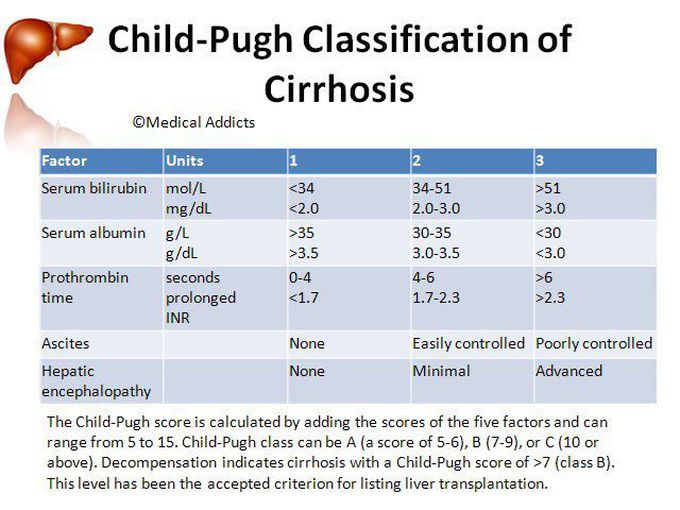Child-Pugh Classification (CPC): Overview, Scoring, and Applications

The Child-Pugh Classification (CPC), also known as the Child-Turcotte-Pugh (CTP) score, is a system used to assess the prognosis of chronic liver disease, primarily cirrhosis. It evaluates liver function based on five clinical parameters and categorizes patients into three classes (A, B, or C) to guide treatment decisions and predict survival outcomes. Below is a detailed explanation of the scoring system and its clinical significance.
Scoring System
The Child-Pugh score assesses five clinical measures of liver disease severity. Each parameter is scored from 1 to 3 points, with higher scores indicating greater dysfunction:
| Measure | 1 Point | 2 Points | 3 Points |
|---|---|---|---|
| Total Bilirubin | <34 μmol/L (<2 mg/dL) | 34–50 μmol/L (2–3 mg/dL) | >50 μmol/L (>3 mg/dL) |
| Serum Albumin | >3.5 g/dL | 2.8–3.5 g/dL | <2.8 g/dL |
| Prothrombin Time | <4 seconds prolonged | 4–6 seconds prolonged | >6 seconds prolonged |
| INR | <1.7 | 1.7–2.3 | >2.3 |
| Ascites | None | Mild (controlled medically) | Moderate to severe |
| Encephalopathy | None | Grade I–II | Grade III–IV |
The total score (ranging from 5 to 15) determines the Child-Pugh class:
- Class A (5–6 points): Mild liver disease; well-compensated liver function.
- Class B (7–9 points): Moderate liver disease; significant functional compromise.
- Class C (10–15 points): Severe liver disease; decompensated cirrhosis.
Interpretation and Prognosis
The Child-Pugh classification provides insights into survival rates and operative risks:
| Points | Class | One-Year Survival | Two-Year Survival |
|---|---|---|---|
| 5–6 | A | ~100% | ~85% |
| 7–9 | B | ~80% | ~60% |
| 10–15 | C | ~45% | ~35% |
Patients in Class A are generally considered good candidates for surgery or other treatments, while those in Class C may require urgent interventions like liver transplantation due to poor prognosis.
Clinical Applications
- Guiding Treatment Decisions:
- Helps determine the strength of treatment required for chronic liver disease or cirrhosis.
- Assists in evaluating surgical risks for procedures like portosystemic shunting or liver resection.
- Transplantation Prioritization:
- Previously used for organ allocation until replaced by the MELD score in transplant centers.
- Prognostic Tool:
- Provides a forecast of survival rates and progression of liver disease based on functional impairment.
- Modified Scoring for Specific Conditions:
- In primary biliary cholangitis or sclerosing cholangitis, bilirubin thresholds may be adjusted due to higher conjugated bilirubin levels.
Limitations of the Child-Pugh Score
- Subjectivity in assessing ascites and encephalopathy can lead to variability between clinicians.
- Does not account for all factors influencing survival, such as renal dysfunction or systemic complications.
Conclusion
The Child-Pugh classification remains a valuable tool for assessing the severity of chronic liver disease and guiding clinical decisions regarding treatment and prognosis. Despite its limitations, it provides a straightforward method to evaluate liver function and predict outcomes.
Consult with Our Team of Experts Now!
At DrStemCellsThailand (DRSCT)‘s Anti-Aging and Regenerative Medicine Center of Thailand, we emphasize comprehensive evaluations and personalized treatment plans of Cellular Therapy and Stem Cells for managing various health conditions. If you have questions about Child-Pugh Classification (CPC) or would like more information on our services, consult with our experts today!















